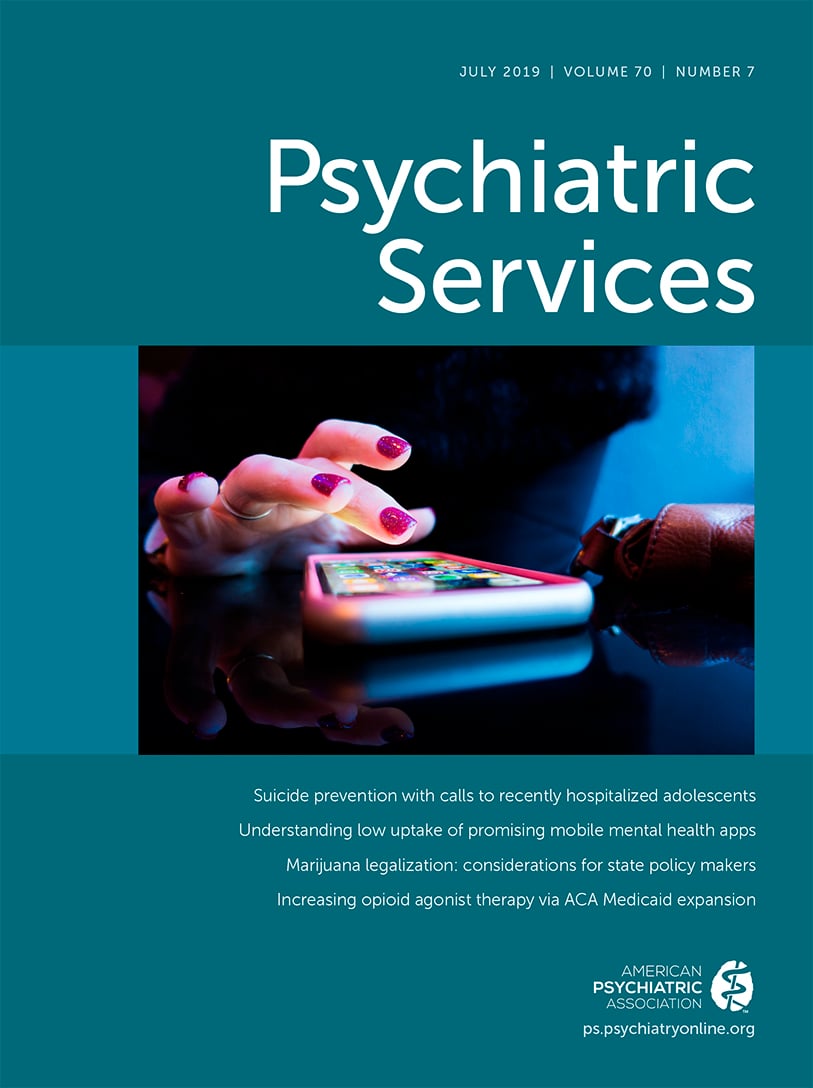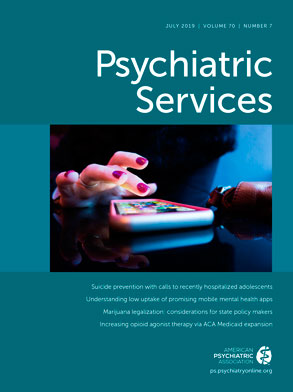Increased emergency department (ED) use and the negative effects of ED overcrowding are well documented (
1,
2). The number of overall ED visits has increased significantly in recent years, and the additional strain at a national level on ED resources, particularly staffing and space, has led to significant ED overcrowding and increases in wait time (
3). ED use for psychiatric services is also significantly more costly (
4). One contributor to the rise in ED visits overall is the disproportionately large increase in children and adolescents presenting for psychiatric conditions (
5,
6). Between 2001 and 2011, pediatric psychiatric ED visits increased from 4.2% to 7.2% of all pediatric ED visits (
7). Unfortunately, causes of pediatric psychiatric ED use remain understudied, especially among high-risk clinical populations.
Patients discharged from psychiatric hospitalization may be at especially high risk of ED use. The 30-day period immediately following discharge is a time of high risk and stress for these patients and their families. Patients are at elevated risk of a recurrence of suicidal thoughts or behaviors that often require immediate intervention in an ED (
8,
9). To the best of our knowledge, no previous studies have explicitly examined clinical predictors of ED use during the critical period following a psychiatric hospitalization. Rather, previous research has focused on determining predictors of hospital readmission—a commonly used marker of negative outcomes adopted from the medical literature.
Although psychiatric rehospitalization may frequently occur after hospitalization, it is not the only possible negative outcome. Because of logistical and economic factors—including referral policies, access to mental health services, lack of insurance, and requirements by insurance providers—the ED is the first and sometimes only line of support for many children needing mental health evaluation or stabilization (
10). Therefore, examination of ED usage may more completely account for patients who require psychiatric services but are not rehospitalized, whether because of lack of need or lack of resources. To date, documentation of ED use as a discrete outcome after psychiatric hospitalization has been underexplored in the pediatric psychiatric literature.
This significant gap in the literature prevents identification of predictive risk factors for emergency care that could support the development of interventions to both improve outcomes for this patient population during a critical high-risk period and reduce the burden in the ED. To address this significant knowledge gap, this study aimed to identify predictors (demographic and clinical characteristics and use of mental health care services) of ED use for a mental health evaluation within 30 days of hospital discharge, by prospectively following patients discharged from a pediatric psychiatric hospitalization.
Methods
This longitudinal, observational study was approved by the study site institutional review board. Parents of children and adolescents discharged to the community from a Boston-area acute inpatient psychiatric hospitalization program were recruited between June 15, 2014, and November 15, 2016, to participate in this study. All study participants provided written, informed consent. Clinical and demographic variables were collected from each patient’s electronic medical record. Parent- and guardian-reported 30-day ED usage was collected by using REDCap, a secure electronic data capture system. At 30 days after discharge, parents and guardians were e-mailed a link to a secure electronic survey by asking whether their child had an “assessment by a hospital ED for a mental health crisis” in the month since discharge from the study site. Between 33 and 45 days after discharge, if parents had not completed the survey, they were contacted with reminders to complete the survey, first via e-mail and then via phone.
Patient demographic variables included age, sex, race, and adoption status. Clinical variables included reason for admission, discharge diagnosis, hospital length of stay (LOS) and type of planned outpatient treatment services (i.e., home with enrollment in a partial hospitalization program [PHP] or home with an appointment for outpatient therapy). The Brief Psychiatric Rating Scale for Children symptom domains were used to measure patient symptom severity on admission. A trauma exposure variable assessed how many types of trauma (physical abuse, sexual abuse, witness to violence, severe neglect, bullying, or traumatic loss) a patient had experienced prior to admission. All of the variables listed above were documented as part of the admission or discharge assessments for all children admitted to the unit by a licensed psychiatrist and were obtained from electronic medical records of intake and discharge summaries by using a chart abstraction tool.
All statistical analyses were performed by using R version 3.5.1. Observations with missing values were ignored. We first selected univariate predictors of ED use, using α=.05, to include in a subsequent multivariate model. We then constructed a logistic regression model of clinical and demographic variables predicting ED use within 30 days of discharge.
Results
Of 242 enrolled parents, 155 (64%) reported whether or not their child had required an ED visit for a mental health crisis within the first 30 days following their hospital discharge. Patient characteristics did not significantly differ on any of the major demographic or clinical categories examined between the groups of parents who reported and did not report on the 30-day ED usage. Of the 155 patients whose parents did report, 116 (75%) were female; 115 (74%) were Caucasian, eight (5%) were Asian, seven (5%) were Hispanic, five (3%) were black, nine (6%) identified as other, and 17 (11%) did not document their ethnicity; 140 (90%) had a mood disorder diagnosis; and 140 (90%) had been hospitalized for risk of harm to self. The patient population had a median age of 15 years (range 7–18 years) with a median hospital LOS of 11 days (range 1–52 days). Trauma exposure was documented on hospital admission; 63 patients (41%) experienced at least one trauma type, 20 (13%) experienced at least two trauma types, and five (3%) experienced three or more trauma types. Of the 155 patients with parent-reported ED usage data, 24 (16%) used the ED for a mental health evaluation within 30 days of discharge. Of these 24 visits, 20 (83%) were by patients who also had a psychiatric rehospitalization.
The results of all variables examined in this study in separate univariate logistic regression models are available as an online supplement to this report. The three statistically significant univariate predictors of ED use included in the subsequent model-building procedure included total reported trauma types (odds ratio [OR]=1.64, 95% confidence interval [CI]=1.30–2.06, z=2.16, p=.031), hospital LOS (OR=1.04, 95% CI=1.03–1.06, z=2.70, p=0.007), and a diagnosis of generalized anxiety disorder (GAD; OR=3.35, 95% CI=2.02–5.56, z=2.40, p=0.028).
We constructed a multivariate logistic regression model by using these selected predictor variables, which resulted in the final main effects model in
Table 1. In this multivariate model, each additional trauma type experienced (OR=1.92,
z=2.67, p=0.008), each additional LOS day (OR=1.05,
z=2.74, p=0.006), and a GAD diagnosis (OR=3.20,
z=1.98, p=0.048) increased risk of ED use within 30 days of discharge. Also presented in
Table 1 is an adjusted model controlling for ethnicity, age, sex, and adoption status. In this model, ORs remained comparable and p values remained statistically significant for LOS, GAD, and trauma types. In Appendix 1 of the
online supplement, we present findings of interaction effects between GAD, LOS, and PHP use postdischarge.
Discussion
Our study found that patients with more lifetime documented trauma types, a GAD diagnosis, or longer LOS were at increased risk of using the ED within 30 days of discharge. Below, we discuss each finding and its clinical implications.
Increased trauma type exposure is associated with increased ED use after a pediatric psychiatric hospitalization. These findings align with research that has found four or more co-occurring trauma types significantly increase the odds of self-harm, suicidal or violent behaviors in a comparable inpatient population (
11). As a majority of patients (90%) are admitted to the study site due to risk of self-harm, complex trauma histories may increase ED use via increased levels of self-harm and suicidal behaviors.
In the final model, both a GAD diagnosis and longer hospital LOS were associated with increased risk of ED use when controlling for other variables. Our findings add to literature that implicates anxiety with increased health care use (
12). In our pediatric population, patients with GAD may be more likely to exhibit behaviors that result in caregivers seeking emergency care.
With regard to hospital LOS, other studies have reported longer LOS to be associated with increased risk of rehospitalization (
13). We found in the final model that risk of ED use in the postdischarge study period increased as hospital LOS increased, while holding other model variables constant. Hospital LOS is a complex variable that may reflect patient acuity or greater psychosocial complexity during hospitalization. The analysis presented in Appendix 1 in the
online supplement details preliminary findings that may elucidate one feature of this complexity, namely that LOS is associated with ED utilization risk differently for patients with GAD than patients without GAD.
The study findings suggest potential targets for improving patient outcomes following a pediatric psychiatric hospitalization, thereby decreasing the high use of ED services for a mental health evaluation for this high-risk population. Interestingly, not all patients who went to the ED for a mental health evaluation were hospitalized. Had rehospitalization been the outcome variable of interest, the negative outcomes for these patients would have been missed. To fully understand the outcomes of patients following a psychiatric hospitalization, researchers should consider collecting both variables in future longitudinal studies, especially in regions with significant differences in mental health care delivery and availability.
The current study had several limitations that should be addressed in future research. Given the absence of studies examining ED use following a pediatric psychiatric hospitalization, this study used a data-driven approach to identify predictors of ED use. Although this approach has the virtue of not excluding potential predictors in an underexplored area of outcomes research, it may increase type I error. Additionally, because of small sample size and a single-site study design, the study findings may not generalize well to other populations. Considering these limitations, future research should aim to replicate these study findings in larger, multisite studies before applying findings to policy and practice. The current study also explored relatively few demographic variables, no ecological variables characterizing the child’s environment, and used a basic measure of trauma. Future studies should more robustly control for socioeconomic status, characterize patients’ ecological environment, and measure trauma exposure.

